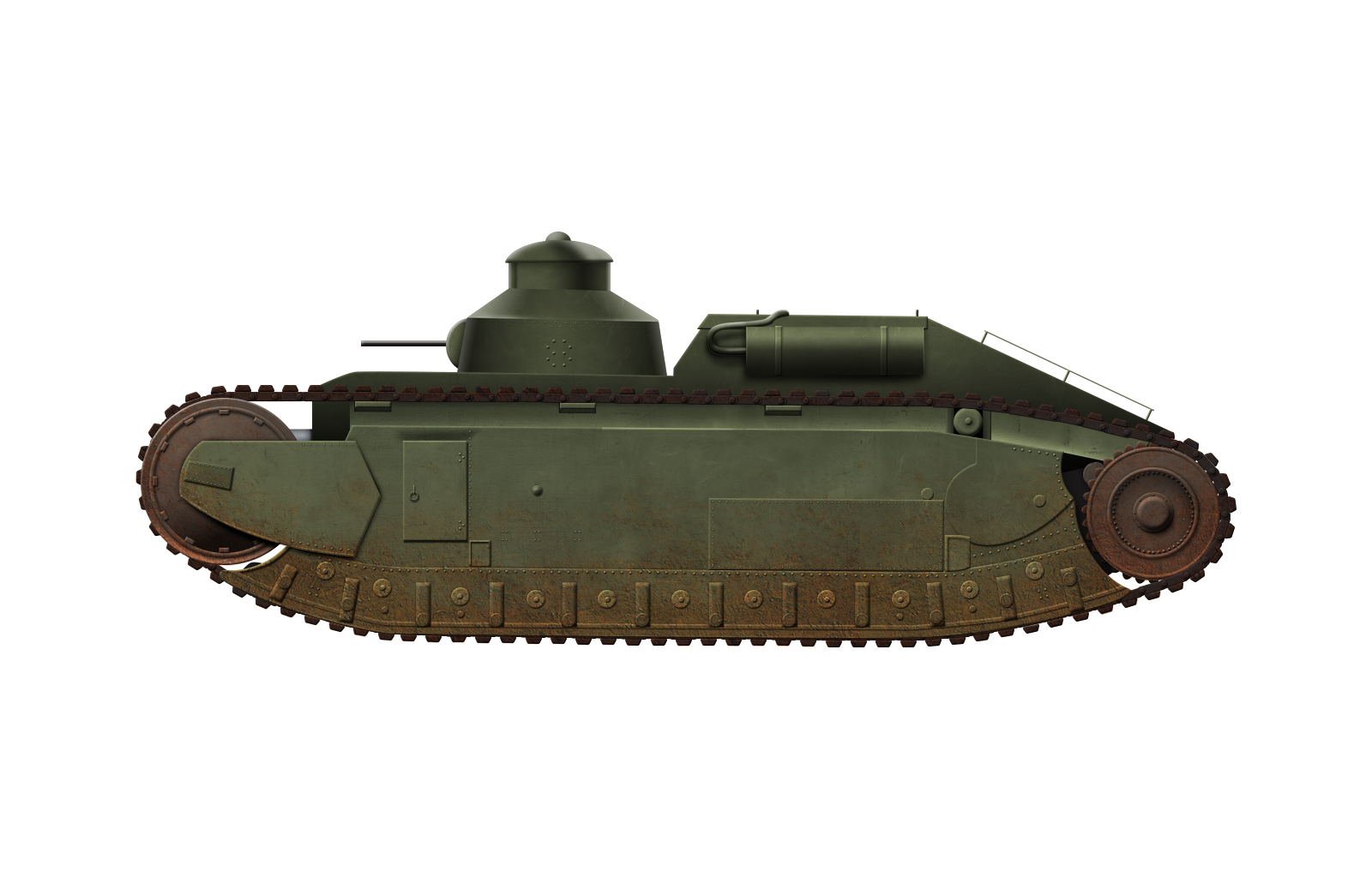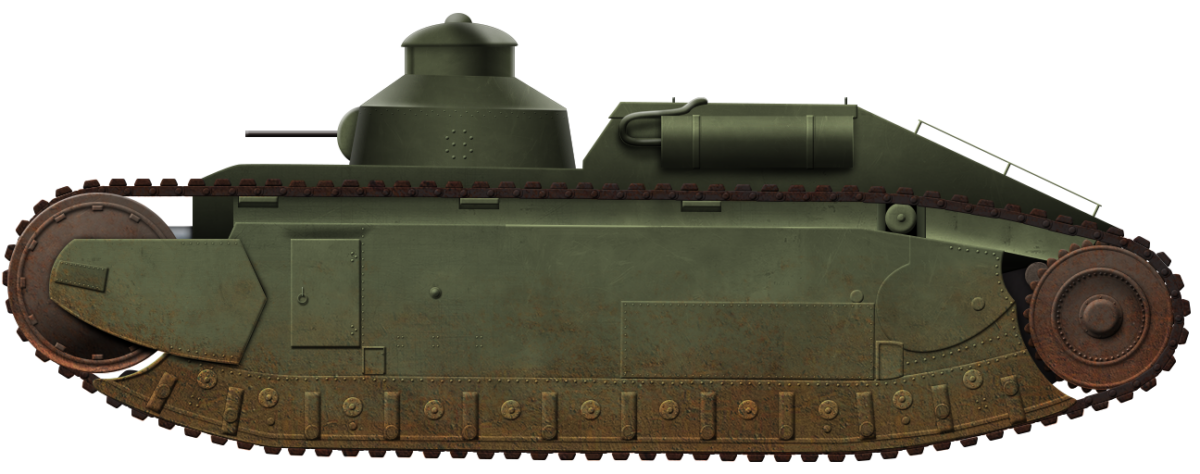 France (1921-1925)
France (1921-1925)
Experimental Infantry Tank – 1 Prototype Built
One of, if not the most famous French tanks of the Second World War was the B1 heavy tank and its improved model, the B1 Bis. These large infantry heavy tanks were some of the most heavily armed and armored tanks existing in the world during the late 1930s. While their production only started in the second half of this decade, they had roots going back as far as 1921, with the Char de Bataille program that started a search for a medium, well-armed tank to fill in the void between the small and numerous Renault FT and the gigantic and rare FCM 2C tanks. One of the proposals to this program was created by the manufacturer of the FCM 2C, Forges et Chantiers de la Méditerranée.
Estienne and the Char de Bataille
Arguably the most important figure of the first years of French tank development was general Jean Estienne. Nicknamed the “Father of Tanks” in France, Estienne, a major proponent of the use of armored vehicles from 1915 onward, was named the director of the AS (Artillerie Spéciale – Special Artillery), the French armored force, in September of 1916. It is largely thanks to his intervention to the Grand Quartier Général, France’s general headquarters, that the FT light tank reached mass production. Estienne was also a proponent of the Schneider CA1, the first French tank to see service.

At the end of the war, Estienne continued in his role as the leading figure of French armored development. He was still at the head of the AS, which was attached to the French infantry and renamed the Subdivision des chars de combat (Combat tank subdivision), and was also named Inspecteur des Chars de Combat (Combat Tank Inspector). In this position, Estienne had large amounts of power over the future development of French armored technology. With the French military having large quantities of largely effective light tanks thanks to the mass production of the Renault FT, and with the development of large tank already underway at FCM since 1916 with the FCM 1A and then FCM 2C super-heavy tanks, what the French military lacked in his view was an intermediate vehicle between the dwarves and the giants. A “Char de Bataille” (battle tank) thought of as a vehicle of medium weight, that would feature a fixed 75 mm gun able to engage enemy fortifications and positions, and to move through the devastated terrain typical of trench warfare in an artillery-saturated battlefield. Estienne thought the type would offer the ideal compromise, mounting an armament capable of knocking out enemy fortifications and trenches, something the FT’s armament of either a machine-gun or a 37 mm gun could struggle with, while being vastly more reasonable and easier to mass-produce than a monster the size and weight of the 69-tons, 10-meters long 2C. If successful, the Char de Bataille would have eventually become the workhorse of France’s armored force.
The Char de Bataille program and the Estienne agreements
In 1921, Estienne gathered five of the largest French industrial companies: Schneider, Renault, FAMH/Saint-Chamond, FCM and Delaunay-Belleville, and gave them the requirements of the Char de Bataille which he requested them to design. The vehicle was to have a weight of 13-tons, and feature a hull-mounted main gun: either a 75 mm howitzer with a muzzle velocity of 350 m/s, or the higher velocity 47 mm mle 1902 naval gun, with 750 m/s muzzle velocity. The tank was to have a turret armed with either one or two machine guns. It was to have a power-to-weight ratio of at least 8 hp per ton, and be able to run for 8 to 10 hours. The armor was to be 25 mm thick.
Most importantly, the program was not planned to result in the immediate adoption of the product that answered to the specifications the most. The plan was that, once the prototypes were produced, the most interesting features from each would be taken to then be featured in a new tank design that would not be the property of a company, but of the state. The objective of such a move was to reduce competition and encourage the manufacturers to innovate without the risk of a yet not entirely mastered concept leading to the refusal of a proposal. Once the vehicle that combined the best features of each proposal was adopted, each of the manufacturers involved would play a part in the production. This original policy was named the Estienne agreements.
The FCM vehicle: Miniature Char 2C
In the end, four manufacturers would produce new designs for the Char de Bataille program. Delaunay-Belleville offered a previous design of theirs, an enlarged FT with a 37 mm hull gun and a turret, that had little to do with the program’s requirements and was swiftly thrown out of the equation. Schneider and Renault cooperated and produced two joint prototypes of different designs, while Saint-Chamond and FCM produced their own prototypes individually.
FCM (Forges et Chantiers de la Méditerranée – Forges and Shipyards of the Mediterranean) was originally a naval shipyard, which became involved in tank production with the FCM 1 heavy tank design that started development in 1916. While it would remain at the prototype stage, the FCM 1 would serve as the basis for the development of the FCM 2C, a 69-tons behemoth. Ordered at first in January of 1918, canceled with the end of the First World War but ordered again by the request of Estienne in April of 1919, albeit only for 10 vehicles, instead of hundreds as originally planned, the FCM 2C took much of FCM’s industrial capacities in the early 20s. The vehicles were completed in 1921, but still received modifications until 1923.

Therefore, it comes as no surprise that FCM’s Char de Bataille design takes much inspiration and many features from the company’s super-heavy tank design. The turret of the new tank was straight-up the rear machine gun-armed turret of the FCM 2C, which would be armed with a Hotchkiss mle 1914 8×50 mm Lebel machine gun (though the prototype was not outfitted with one). Just like the FCM 2C, the FCM Char de Bataille featured a large engine block protruding from the hull, meaning the turret would only cover the forward firing arc.
Features and trials of the prototype
FCM’s Char de Bataille was trialed along with the three other vehicles in Rueil, starting with their presentation on the 13th of May 1924.

The FCM Char de Bataille prototype was a 6.50 meters-long, 2.52 m high, 2.05 m wide tank. It was the longest and highest, but also the narrowest and lightest of the four Char de Bataille designs, though, with a weight of 15,640 kg, it still exceeded the requirements of the program by over two and a half tons. The ground clearance was also the highest, at 0.50 m.
The vehicle was powered by a Panhard engine with an output of 120 hp at 1500 rpm. This was the same engine as the Saint-Chamond prototype, though the FCM’s lower weight meant it had a horsepower per ton ratio of 7.7 hp/ton, almost reaching the requirements of the program. The Saint-Chamond had merely 7 hp/ton, while the two Schneider-Renault featured a more powerful 180 hp engine that gave them both 9.5 hp/ton. This engine allowed the tank to reach a maximum speed of 17.4 km/h, which was quite respectable for early 1920s standards. The FCM had the largest fuel tank of any of the Char de Bataille, 500 liters, though it also had the highest hourly consumption of 35 liters. It had the greatest range of all vehicles, with 175 km. The tank had a suspension of which the exact workings are unclear. It consisted of fifteen small road wheels, with a large front idler and a smaller rear drive sprocket. The suspension was apparently moved by a “Chaîne galle”, a type of mechanical piece usually used in barrages, great at transmitting high efforts at low speeds, which was kept tense by a pneumatic system. The tracks used were inspired by Holt tractor tracks which used wooden pads, with a quite long track pitch. These tracks went all around the hull, as with British rhomboid tanks such as the Mark I and IV. French experience with the CA 1 and particularly Saint-Chamond tanks had shown that tanks with too small of a track run performed far worse in terrain battered by artillery craters.

The FCM Char de Bataille featured 25 mm of armor. Its main armament was a 75 mm gun located on the right of the hull. Unlike other vehicles, which had the gun in some sort of casemate or mount, the FCM’s gun went straight through the armor plate. Most sources mention a hull machine gun was also featured, though the lack of clear photos of the vehicle’s front makes it hard to confirm that claim. The turret is often claimed to feature two machine guns, but this appears not to be the case as it was taken straight from the FCM 2C, and was of a cylindrical design which would be hard to arm with two forward-firing machine guns. As with other tanks of the Char de Bataille program, this turret was the place from which the commander gave orders to the two other crew members. In combat, the machine gun was to be used mostly to defend the vehicle from enemy infantry. The driver sat to the left of the hull, with the third crewman, tasked with loading the 75 mm gun, sitting to the right; considering the vehicle was the narrowest, it appears the two crewmen sitting in the hull were quite cramped.
Conclusion – A mostly inconsequential design
The trials of the Char de Bataille lasted from May of 1924 to March of 1925. The FCM appeared to have had an unreliable gearbox, and the tracks using wooden pads, used by all prototypes but the Schneider-Renault B, proved to wear down a lot quicker than metallic tracks. Little else is known about the results of the trials.

Out of the four Char de Bataille prototypes, the FCM is arguably the one which had the least inspiration taken from for the definitive design, which would become the B1. While the suspension of the final product was mostly inspired by the Saint-Chamond/FAMH, and most of the hull design as well as features, such as the Naeder hydrostatic system allowing for accurate hull movements, were taken from the Schenider-Renault prototypes, the influence of the FCM appears limited to the track-tensioning and clutch systems.
The fate of the FCM prototype beyond the trials is unknown, though the most likely way it ended its life was in a scrapyard.

Char de Bataille FCM specifications |
|
| Dimensions (L x w x h) | 6.50 x 2.05 x 2.52 m |
| Ground Clearance | 0.50 m |
| Weight | 15,640 kg |
| Engine | Panhard producing 120 hp at 1500 rpm |
| Maximum speed | 17.4 km/h |
| power-to-weight ratio (in hp/ton) | 7.7 |
| Fuel tanks | 500 liters |
| Average hourly fuel consumption | 35 liters |
| Range | 175 km |
| Crew | 3 men (Commander/turret gunner, driver/gunner, loader) |
| Armament | 1 turret-mounted Hotchkiss mle 1914 8 mm machine gun 1 hull-mounted 75 mm howitzer Possibly 1 hull-mounted Hotchkiss mle 1914 8 mm machine gun |
| Armor | 25 mm maximum |
Sources
Tous les blindés de l’Armée Française 1914-1940, François Vauvillier, Histoire & Collection editions, p 42-43
GBM N°107 (January-February-March 2014), Histoire & Collections editions, “Les voies difficultueuses du char de bataille”, p 45-46, Stéphane Ferrard
Trackstory N°3 : Les chars B, Editions du Barbotin, p 5-7
Tank Archives
Char-français

